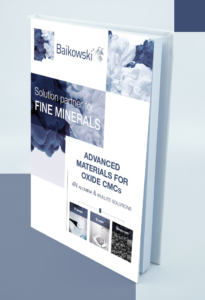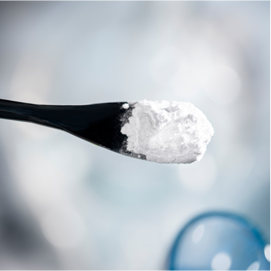Why could Matrix Doping be the Key to Thermal Stability in Oxide CMCs?
Across the aerospace and energy industries worldwide, oxide Ceramic Matrix Composites (Ox-CMCs) play a key role in demanding applications such as gas turbine engines, aerospace thermal protection systems, and energy generation components.
Their outstanding mechanical strength, thermal stability, and chemical resistance make them essential in environments where other materials fail. However, ensuring long-term stability above 1000 °C remains a challenge, mainly due to grain coarsening and material degradation.
Advanced Research: Matrix Doping for Thermal Stability
A recent study, University of Bremen study on Ox-CMCs, investigated ways to preserve microstructure and strength at high temperatures.
Baikowski® contributed to this research with its Baikalox® BA15 alumina powder, selected for its:
• Ultra-high purity
• Narrow particle size distribution (d₅₀ = 120 nm)
These attributes ensured a consistent and reliable matrix material, critical for evaluating the effects of doping. For that, water-based ceramic suspensions containing a solid content of 50 vol% were prepared.
Materials and Methods Overview
 • Reinforcement: Composites reinforced with Nextel™ 610 fibers and alumina matrices
• Reinforcement: Composites reinforced with Nextel™ 610 fibers and alumina matrices
• Matrix Variations: Non-doped alumina vs. MgO-doped alumina (480 ppm). MgO was chosen due to its recognized ability to inhibit grain boundary mobility and reduce grain growth, making it an effective doping agent for enhancing thermal stability.
• Processing Route: Ionotropic gelation, sintered at 1200°C, then heat-treated at 1300°C and 1400°C
• Characterization: SEM, WDX, and tensile strength testing
Key Results of doped BA15
🌟 Microstructural Improvements
• Both composites started with uniform, equiaxial grains
• After heat exposure, MgO-doped composites showed refined grains and fewer abnormal grain formations, especially near fiber regions
🌟 Elemental Interactions
• WDX analysis showed that silicon (Si), which is part of the Nextel 610 fibers, diffuses outward toward the matrix after heat exposure
• Magnesium (Mg) from the matrix diffuses slightly into the fibers. This interaction helped suppress excessive grain coarsening in MgO-doped composites, leading to narrower fiber grain size distributions and smaller grains compared to non-doped samples
• Result: reduced strength loss after heat treatments
🌟 Mechanical Performance
• Initial tensile strength: ~135 MPa for both doped and non-doped composites
• Post-treatment strength retention:
– 1300 °C: MgO-doped → 8% loss (vs. 27% for non-doped)
– 1400 °C: MgO-doped → 41% loss (vs. 62% for non-doped)
👉 The customized doped alumina matrix significantly limited fiber grain growth and maintained mechanical properties under high-temperature exposure.
Baikowski customization benefits?
 With more than 100 years of expertise and strong R&D capabilities, Baikowski® delivers tailored high-purity oxides for critical applications such as aerospace and energy.
With more than 100 years of expertise and strong R&D capabilities, Baikowski® delivers tailored high-purity oxides for critical applications such as aerospace and energy.
Our ability to engineer customized alumina powders and slurries ensures optimal performance in your most demanding processes across EMEA, the Americas, and APAC.
Explore our CMC solutions portfolio, including:
• Baikalox® BA15 powder → High-purity alumina for matrix formulations
• SLAZ slurry → Alumina doped with Mathym’s zilight® nano-zirconia for advanced thermal protection
👉 Eager to learn more about Advanced Materials for oxide CMCs

